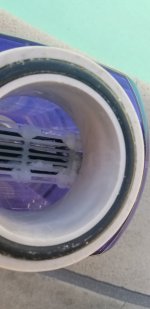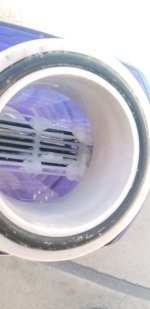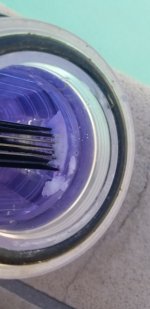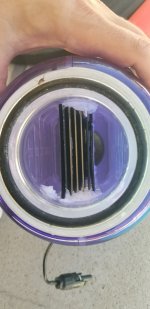- May 1, 2021
- 45
- Pool Size
- 17000
- Surface
- Plaster
- Chlorine
- Salt Water Generator
- SWG Type
- CircuPool Edge-40
Over the last couple months I have had an issue with mushy white buildup around the ends of my SWG cell plates, which has never happened before. In the past when I would get scaling, before I really held my pH in check and my TA was double what it is now, it would be hard and would take some effort to actually break it into pieces. Now it's just this mushy white grit.
Two weeks ago I cleaned a lot of it off after the check cell light on my Edge 40 panel was on. Now the check cell light is on again, but intermittently it goes off and the SWG seems to operate normally when the light is off.
This cell is only 17 months old so I would think nowhere near end of life. During summer I do run my pump and SWG 24h/day at 1800rpm and the lowest SWG setting.
I have been adding liquid chlorine (10%) as needed for 4-6 weeks now, but have only needed to add about 1.5gal total in that time. Partly because the SWG is still working about half the time, and partly because I have the pool mostly half-covered with a solar cover. Early June is when I started using the solar cover, so this issue has at least correlated with the increased pool temperature.
My pool chemistry is and has been around the following consistently for the past 6 weeks. Before then, I was consistently testing pH/FC consistently and the others every few months. I add MA every time I see the pH even getting close to 7.8 to keep CSI < 0. Ends up close to a gallon of acid per month.
Temp - 86 degrees
pH - 7.5
FC - 5
CC - 0
TA - 60
CH -425 600
CYA- 20 (adding some soon)
Salt - 3800
CSI using the above is-0.21 -0.07 per poolmath.
I just took apart my DE filter for the first time yesterday, and I am in the process of reassembling now (needed a new standpipe o-ring). If it matters, I use Aquaperl perlite instead of DE. Some observations:
1. Two of the grids had a full layer of sandwiched gunk/media between them. The other grids were consistently covered with a thin layer of gray used media like what I've seen in filter cleaning videos.
2. The grid meshes are all intact, but when I went to pull up the top manifold, it actually came up a bit without the grids. I am thinking whoever last assembled it did not have it set properly to get the thumbscrews snug. So, perhaps some residue from the pool/filter could have made it to the outlet pipe without really being filtered.
3. The pool has been very clear so the filter is definitely still functioning overall. Backwashing the filter does result in murky gray water at first and clear water after 1-2 minutes. Very curious to see what my filter pressure will be after cleaning these grids though.
I'll update this thread after getting the filter back up and running, but I wanted to know if there's any chance the filter could have been the culprit here, like it's letting through some sediment?
Do I just need to keep my pH even lower during summer when the pool gets up to 85-90 degrees?
Does anyone have issues like this while running a VS pump at a low RPM constantly? I wonder if a 3000rpm cycle every day would wash this away.
Two weeks ago I cleaned a lot of it off after the check cell light on my Edge 40 panel was on. Now the check cell light is on again, but intermittently it goes off and the SWG seems to operate normally when the light is off.
This cell is only 17 months old so I would think nowhere near end of life. During summer I do run my pump and SWG 24h/day at 1800rpm and the lowest SWG setting.
I have been adding liquid chlorine (10%) as needed for 4-6 weeks now, but have only needed to add about 1.5gal total in that time. Partly because the SWG is still working about half the time, and partly because I have the pool mostly half-covered with a solar cover. Early June is when I started using the solar cover, so this issue has at least correlated with the increased pool temperature.
My pool chemistry is and has been around the following consistently for the past 6 weeks. Before then, I was consistently testing pH/FC consistently and the others every few months. I add MA every time I see the pH even getting close to 7.8 to keep CSI < 0. Ends up close to a gallon of acid per month.
Temp - 86 degrees
pH - 7.5
FC - 5
CC - 0
TA - 60
CH -
CYA- 20 (adding some soon)
Salt - 3800
CSI using the above is
I just took apart my DE filter for the first time yesterday, and I am in the process of reassembling now (needed a new standpipe o-ring). If it matters, I use Aquaperl perlite instead of DE. Some observations:
1. Two of the grids had a full layer of sandwiched gunk/media between them. The other grids were consistently covered with a thin layer of gray used media like what I've seen in filter cleaning videos.
2. The grid meshes are all intact, but when I went to pull up the top manifold, it actually came up a bit without the grids. I am thinking whoever last assembled it did not have it set properly to get the thumbscrews snug. So, perhaps some residue from the pool/filter could have made it to the outlet pipe without really being filtered.
3. The pool has been very clear so the filter is definitely still functioning overall. Backwashing the filter does result in murky gray water at first and clear water after 1-2 minutes. Very curious to see what my filter pressure will be after cleaning these grids though.
I'll update this thread after getting the filter back up and running, but I wanted to know if there's any chance the filter could have been the culprit here, like it's letting through some sediment?
Do I just need to keep my pH even lower during summer when the pool gets up to 85-90 degrees?
Does anyone have issues like this while running a VS pump at a low RPM constantly? I wonder if a 3000rpm cycle every day would wash this away.
Attachments
Last edited:






 Today I am getting 24 drops, so CH = 600 which puts CSI at 0.12 for pH=7.7 and 86 degree water. pH was 7.7 right now so I added some acid after testing.
Today I am getting 24 drops, so CH = 600 which puts CSI at 0.12 for pH=7.7 and 86 degree water. pH was 7.7 right now so I added some acid after testing.